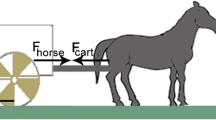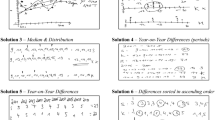Abstract
A common approach for introducing students to a new science concept is to present them with multiple cases of the phenomenon and ask them to explore. The expectation is that students will naturally take advantage of the multiple cases to support their learning and seek an underlying principle for the phenomenon. However, the success of such tasks depends not only on the structure of the cases, but also the task that students receive for working with the examples. Two studies used contrasting cases in the context of teaching middle-school students about projectile motion. Using a simulation and the same set of cases for all students, students completed a traditional “compare and contrast” approach, or an instructional method called “inventing,” where students try to produce a single general explanation. The results show that inventing led to superior learning. Examination of student worksheets revealed that the “compare and contrast” instruction led students to focus mostly on the level of discrete, surface features of the phenomenon. Rather than trying to account for the variation across cases, students simply noticed each instance of it. In contrast, the inventing task led students to consider how the variations across the cases were related. As a result, “invent” students were more likely to search for and find the unifying functional relation. Driving towards an overall explanation is a fundamental tenet of science, and therefore, it is worthwhile to teach students to do the same.








Similar content being viewed by others
References
Alfieri, L., Nokes-Malach, T. J., & Schunn, C. D. (2013). Learning through case comparisons: A meta-analytic review. Educational Psychologist, 48(2), 87–113. doi:10.1080/00461520.2013.775712.
Biederman, I., & Shiffrar, M. M. (1987). Sexing day-old chicks: A case study and expert systems analysis of a difficult perceptual-learning task. Journal of Experimental Psychology: Learning, Memory, and Cognition, 13(4), 640–645.
Bonwell, C. C., & Eison, J. A. (1991). Active learning: Creating excitement in the classroom (ASHE–ERIC Higher Education Rep. No. 1). Washington, DC: The George Washington University, School of Education and Human Development.
Bransford, J. D., Brown, A. L., & Cocking, R. R. (1999). Learning from speculation to science. In How People (Ed.), Learn: Mind, brain, experience and school. Washington, DC: National Research Council.
Bransford, J. D., Franks, J. J., Vye, N. J., & Sherwood, R. D. (1989). New approaches to instruction: Because wisdom can’t be told. In S. Vosniadou & A. Ortony (Eds.), Similarity and analogical reasoning (pp. 470–497). New York, NY: Cambridge.
Chi, M. T. H. (2009). Active-constructive-interactive: A conceptual framework for differentiating learning activities. Topics in Cognitive Science, 1(1), 73–105. doi:10.1111/j.1756-8765.2008.01005.x.
Chi, M. T. H., Feltovich, P. J., & Glaser, R. (1981). Categorization and representation of physics problems by experts and novices. Cognitive Science, 5, 121–152.
Christie, S., & Gentner, D. (2010). Where hypotheses come from: Learning new relations by structural alignment. Journal of Cognition and Development, 11(3), 356–373. doi:10.1080/15248371003700015.
Eisner, E. W. (1972). Educating artistic vision. New York: The Macmillan Company.
Finn, J. D., & Zimmer, K. S. (2012). Student engagement: What is it? Why does it matter? In S. L. Christenson, A. L. Reschly, & C. Wylie (Eds.), Handbook of research on student engagement (pp. 97–131). New York, NY: Springer.
Fredricks, J. A., Blumenfeld, P. C., & Paris, A. H. (2004). School engagement: Potential of the concept, state of the evidence. Review of Educational Research, 74(1), 59–109. doi:10.3102/00346543074001059.
Freeman, S., Eddy, S. L., McDonough, M., Smith, M. K., Okoroafor, N., Jordt, H., & Wenderoth, M. P. (2014). Active learning increases student performance in science, engineering, and mathematics. Proceedings of the National Academy of Sciences, 111(23), 8410–8415. doi:10.1073/pnas.1319030111.
Fried, L. S., & Holyoak, K. J. (1984). Induction of category distributions: A framework for classification learning. Journal of Experimental Psychology: Learning, Memory, and Cognition, 10, 234–257.
Gentner, D., Loewenstein, J., & Thompson, L. (2003). Learning and transfer: A general role for analogical encoding. Journal of Educational Psychology, 95, 393–408. doi:10.1037/0022-0663.95.2.393.
Gibson, J. J., & Gibson, E. J. (1955). Perceptual learning: Differentiation or enrichment. Psychological Review, 62, 32–51.
Gick, M. L., & Holyoak, K. J. (1983). Schema induction and analogical transfer. Cognitive Psychology, 15, 1–38.
Gick, M. L., & Paterson, K. (1992). Do contrasting examples facilitate schema acquisition and analogical transfer? Canadian Journal of Psychology, 46(4), 539–550.
Goldstone, R. L., & Son, J. Y. (2005). The transfer of scientific principles using concrete and idealized simulations. The Journal of the Learning Sciences, 14(1), 69–110. doi:10.1207/s15327809jls1401_4.
Hallinen, N. R., Chi, M., Chin, D. B., Prempeh, J., Blair, K. P., & Schwartz, D. L. (2012). Applying cognitive developmental psychology to middle school physics learning: The rule assessment method. In Physics Education Research Conference Proceedings, Philadelphia, PA.
Hatano, G., & Inagaki, K. (1986). Two courses of expertise. In H. Stevenson, H. Azuma, & K. Hakuta (Eds.), Child development and education in Japan. New York: Freeman.
Hestenes, D., Wells, M., & Swackhamer, G. (1992). Force concept inventory. The Physics Teacher, 30, 141–158.
Lepper, M. R., Greene, D., & Nisbett, R. E. (1973). Undermining children’s intrinsic interest with extrinsic reward: A test of the “overjustification” hypothesis. Journal of Personality and Social Psychology, 28(1), 129–137.
Maloney, D. P. (1988). Novice rules for projectile motion. Science Education, 72(4), 501–513.
Marton, F., & Booth, S. (1997). Learning and Awareness. Mahwah, NJ: Erlbaum.
Prince, M. (2004). Does active learning work? A review of the research. Journal of Engineering Education, 93(3), 223–231. doi:10.1002/j.2168-9830.2004.tb00809.x.
Richland, L. E., & Simms, N. (2015). Analogy, higher order thinking, and education. Wiley Interdisciplinary Reviews: Cognitive Science, 6(2), 177–192. doi:10.1002/wcs.1336.
Rittle-Johnson, B., & Star, J. (2007). Does comparing solution methods facilitate conceptual and procedural knowledge: An experimental study on learning to solve equations. Journal of Educational Psychology, 99, 561–574. doi:10.1037/0022-0663.99.3.561.
Rittle-Johnson, B., & Star, J. R. (2009). Compared to what? The effects of different comparisons on conceptual knowledge and procedural flexibility for equation solving. Journal of Educational Psychology, 101(3), 529–544. doi:10.1037/a0014224.
Schwartz, D. L., & Bransford, J. D. (1998). A time for telling. Cognition & Instruction, 16, 475–522.
Schwartz, D. L., Chase, C. C., Oppezzo, M. A., & Chin, D. B. (2011). Practicing versus inventing with contrasting cases: The effects of telling first on learning and transfer. Journal of Educational Psychology, 103(4), 759–775. doi:10.1037/a0025140.
Schwartz, D. L., & Martin, T. (2004). Inventing to prepare for future learning: The hidden efficiency of encouraging original student production in statistics instruction. Cognition and Instruction, 22(2), 129–184.
Shemwell, J., Chase, C., & Schwartz, D. L. (2015). Seeking the general explanation: A test of inductive activities for learning and transfer. Journal of Research in Science Teaching, 52(1), 58–83.
Williams, J. J., & Lombrozo, T. (2010). The role of explanation in discovery and generalization: Evidence from category learning. Cognitive Science, 34, 776–806. doi:10.1111/j.1551-6709.2010.01113.x.
Author information
Authors and Affiliations
Corresponding author
Rights and permissions
About this article
Cite this article
Chin, D.B., Chi, M. & Schwartz, D.L. A comparison of two methods of active learning in physics: inventing a general solution versus compare and contrast. Instr Sci 44, 177–195 (2016). https://doi.org/10.1007/s11251-016-9374-0
Received:
Accepted:
Published:
Issue Date:
DOI: https://doi.org/10.1007/s11251-016-9374-0




